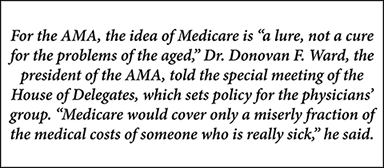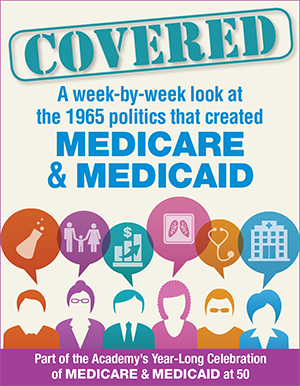Bob Rosenblatt, Special Correspondent
Welcome to Covered: A Week-by-Week Look at the 1965 Politics that Created Medicare and Medicaid. Bob Rosenblatt, a Senior Fellow at the National Academy of Social Insurance, former Los Angeles Times Washington correspondent, and editor of the website HelpWithAging will blog on the maneuvers that led to the enactment of Medicare and Medicaid on July 30th, 1965 the first major expansion of U.S. social insurance to health care.
AMA Blasts Administration’s Medicare Proposal
February 6, 1965
By Bob Rosenblatt, Special Correspondent
Washington, DC – The American Medical Association, the nation’s largest professional group representing physicians, has denounced a proposal by President Lyndon Johnson to provide hospital care for those over 65 and pledged a fight to block the measure from becoming law.
President Johnson tried last year to expand Social Security to create the new hospital benefit and the bill passed the Senate before dying in the House. Fortified by an expanded majority after winning a landslide election, Johnson is trying once again to get Congress to adopt the new program, called Medicare.
For the AMA, the idea of Medicare is “a lure, not a cure for the problems of the aged,” Dr. Donovan F. Ward, the president of the AMA, told the special meeting of the House of Delegates, which sets policy for the physicians’ group. “Medicare would cover only a miserly fraction of the medical costs of someone who is really sick,” he said.
Under the administration proposal, only care in the hospital would be covered. Neither bills from doctors outside the hospital, nor the cost of prescription drugs taken outside the hospital would be covered. “The patient pays for these things,” said Dr. Ward. “When the [hospital] bed-time runs out, the government runs out,” he said.
AMA is pushing its own program, called “Eldercare,” to promote the sale of private medical insurance for those over 65. For those too poor to afford insurance, the AMA proposes the distribution of federal funds to the states. As part of its welfare programs, each state would set the income level for people to qualify for a cash payment that could be used to buy the insurance coverage.
The AMA’s House of Delegates, meeting in Chicago, promised a nationwide campaign of television and newspaper advertising and rallies to defeat the Medicare proposal. The gathering was just the fifth special session in AMA history, demonstrating the depth of feeling among doctors against any expansion of the government’s role in health care.
The AMA’s action sets up a tough political challenge for the proposed legislation, now being considered by the House Ways and Means Committee. The AMA has been a persistent opponent of any effort to expand the role of the federal government in the field of health care. The organization helped defeat a plan by former President Harry Truman to pass national health care legislation during his years in the White House. And the AMA worked hard to convince House Ways and Means Committee members last year to reject a Johnson Administration plan.
This year’s approach by the Administration calls for coverage of 60 days in the hospital and 240 days of home care visits after a hospital stay. It would be financed by a tax on workers and employers of 9/10 of 1% of wages, up to a maximum wage base of $5,000 a year.
The Republican minority in the House appear split on the issue. Rep. Thomas B. Curtis (R-MO) has joined conservative Democrat Sydney Herlong Jr. (FL) to support the AMA bill. But other Republicans, including the new House minority leader, Rep. Gerald Ford (R-MI), are pushing their own program called “Bettercare,” which has a voluntary approach to promote private coverage. They want the federal government to create a voluntary national insurance program, where people could buy private policies anywhere in the country. The federal government would provide funds out of annual appropriations for those too poor to afford insurance.
The Republican leadership plan was introduced by Rep. John W. Byrnes (R-WI), the ranking minority member on the Ways & Means Committee. But the split in the Republican delegation dashes the Ford’s hope of presenting a unified alternative to President Johnson’s proposal.
Both the AMA plan and the GOP proposal would cover hospital care, and doctor bills. Both are focused on expanding welfare to help low-income seniors. The Administration bill would be restricted to covering hospital bills and it would create a mandatory program, where all workers and their employers must pay taxes to pay for health care coverage for their fellow Americans over age 65, similar to the fund used to finance Social Security retirement benefits. This is the only way to assure universal coverage for those over 65, the Democrats argue. They call it social insurance, because it covers all members of society.
“The advantage of the social security approach is that you distribute this cost over a large number of people over a long period of time, and by taking relatively small amounts from people over a working lifetime to enable people to bear what would be a very large cost if financed in old age,” Wilbur Cohen, Assistant Secretary of Health, Education and Welfare, told a closed hearing of the House Way and Means Committee. The Committee, which has 17 Democrats and 8 Republicans, is expected to report out a bill by the middle of March.
The country doesn’t need a mandatory program because private coverage among people 65 and over is steadily increasing, according to Rep. Curtis, a committee member. “Every year the coverage goes up,” he said at the hearing. Sources made available the transcripts from the closed hearing.
The Administration decided to focus on hospital care because that is where prices are rising fastest. The cost of insurance to cover doctor bills is rising less than the cost of inflation. But hospital charges have risen 2.7% faster than wages during the past 10 years.
Johnson Administration officials acknowledge that many people have insurance coverage, but argue that a new program is needed because coverage is limited among low and middle income seniors. Among those in the top third of earners, 80% of couples are covered, along with 66% of single women and 64% of mean. In households in the lowest third of income, 42% of married couples are covered and 31% of single women and 15% of single men.
Chairman Mills’ decision to go straight to executive session may indicate that he has dropped his opposition to the idea of Medicare as a new benefit, perhaps as a result of the elections last November.
But with the AMA’s continued antagonism to the idea, and with the GOP proposal in play, the Johnson Administration faces a serious challenge: how to gain the support of a majority in both the House and the Senate.
There are three big health insurance ideas now in circulation — and it’s far from clear which one will prevail.
►See the next post in the COVERED Series, “State Welfare Directors Press Mills for Health Assistance to the Poor” February 13, 1965
► Learn more about the Academy’s celebration of 50th anniversary of the enactment of Medicare and Medicaid

